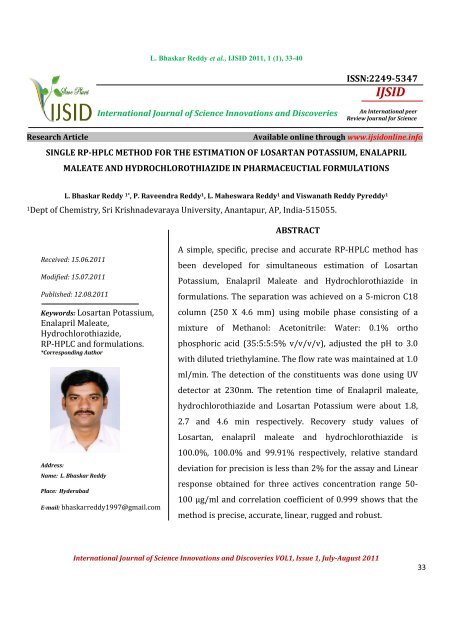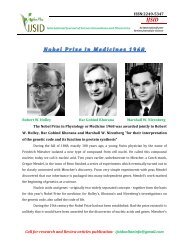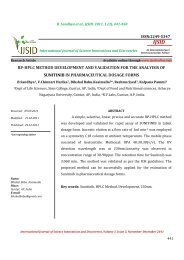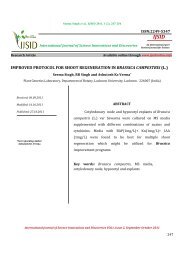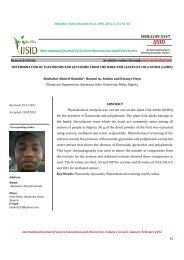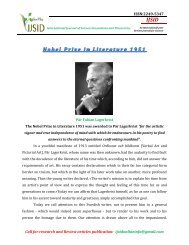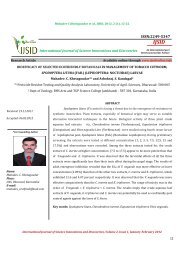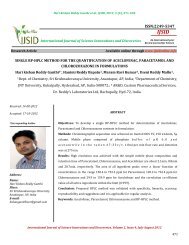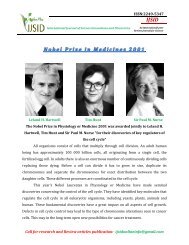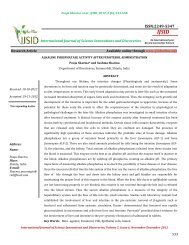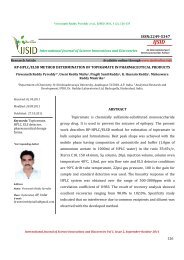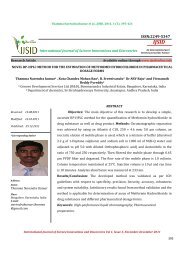single rp-hplc method for the estimation of losartan ... - Ijsidonline.info
single rp-hplc method for the estimation of losartan ... - Ijsidonline.info
single rp-hplc method for the estimation of losartan ... - Ijsidonline.info
Create successful ePaper yourself
Turn your PDF publications into a flip-book with our unique Google optimized e-Paper software.
L. Bhaskar Reddy et al., IJSID 2011, 1 (1), 33-40ISSN:2249-5347IJSIDInternational Journal <strong>of</strong> Science Innovations and DiscoveriesAn International peerReview Journal <strong>for</strong> ScienceResearch ArticleAvailable online through www.ijsidonline.<strong>info</strong>SINGLE RP-HPLC METHOD FOR THE ESTIMATION OF LOSARTAN POTASSIUM, ENALAPRILMALEATE AND HYDROCHLOROTHIAZIDE IN PHARMACEUCTIAL FORMULATIONSL. Bhaskar Reddy 1* , P. Raveendra Reddy 1 , L. Maheswara Reddy 1 and Viswanath Reddy Pyreddy 11Dept <strong>of</strong> Chemistry, Sri Krishnadevaraya University, Anantapur, AP, India-515055.ABSTRACTReceived: 15.06.2011Modified: 15.07.2011Published: 12.08.2011Keywords: Losartan Potassium,Enalapril Maleate,Hydrochlorothiazide,RP-HPLC and <strong>for</strong>mulations.*Corresponding AuthorA simple, specific, precise and accurate RP-HPLC <strong>method</strong> hasbeen developed <strong>for</strong> simultaneous <strong>estimation</strong> <strong>of</strong> LosartanPotassium, Enalapril Maleate and Hydrochlorothiazide in<strong>for</strong>mulations. The separation was achieved on a 5-micron C18column (250 X 4.6 mm) using mobile phase consisting <strong>of</strong> amixture <strong>of</strong> Methanol: Acetonitrile: Water: 0.1% orthophosphoric acid (35:5:5:5% v/v/v/v), adjusted <strong>the</strong> pH to 3.0with diluted triethylamine. The flow rate was maintained at 1.0ml/min. The detection <strong>of</strong> <strong>the</strong> constituents was done using UVdetector at 230nm. The retention time <strong>of</strong> Enalapril maleate,hydrochlorothiazide and Losartan Potassium were about 1.8,2.7 and 4.6 min respectively. Recovery study values <strong>of</strong>Losartan, enalapril maleate and hydrochlorothiazide is100.0%, 100.0% and 99.91% respectively, relative standardAddress:Name: L. Bhaskar ReddyPlace: HyderabadE-mail: bhaskarreddy1997@gmail.comdeviation <strong>for</strong> precision is less than 2% <strong>for</strong> <strong>the</strong> assay and Linearresponse obtained <strong>for</strong> three actives concentration range 50-100 μg/ml and correlation coefficient <strong>of</strong> 0.999 shows that <strong>the</strong><strong>method</strong> INTRODUCTIONis precise, accurate, linear, rugged and robust.International Journal <strong>of</strong> Science Innovations and Discoveries VOL1, Issue 1, July-August 201133
L. Bhaskar Reddy et al., IJSID 2011, 1 (1), 33-40INTRODUCTIONLosartan Potassium (1-3) , 2-butyl-4-chloro-1-[[2’-(1H-tetrazol-5-yl) [1, 1’-biphenyl]-4-yl] methyl]-1Himidazole- 5-methanol mono Potassium salt. It is <strong>the</strong> first member <strong>of</strong> a new class <strong>of</strong> nonpeptideangiotensin II receptor antagonist. It is used to treat hypertension by suppressing <strong>the</strong> effects <strong>of</strong>angiotensin II at its receptors, <strong>the</strong>reby blocking <strong>the</strong> renin-angiotensin system. Losartan has beendemonstrated to be superior to previous peptide receptor antagonists and angiotensin convertingenzyme inhibitors because <strong>of</strong> its enhanced specificity, selectivity, and tolerability. Losartan potassium ismarketed alone or combined with hydrochlorothiazide.Hydrochlorothiazide (HCTZ) (4, 5) is a thiazide class diuretic drug. This reduces <strong>the</strong> volume <strong>of</strong> <strong>the</strong>blood, decreasing blood return to <strong>the</strong> heart. Hydrochlorothiazide is <strong>of</strong>ten used in <strong>the</strong> treatment <strong>of</strong>hypertension, congestive heart failure, symptomatic edema and <strong>the</strong> prevention <strong>of</strong> kidney stones. Therecommended dose <strong>of</strong> hydrochlorothiazide <strong>for</strong> treating high blood pressure is hydrochlorothiazide 25 mgto 50 mg per day.Enalapril maleate (6-8) is used to treat high blood pressure (hypertension), it works by relaxingblood vessels, causing <strong>the</strong>m to widen. Lowering high blood pressure helps prevent strokes, heart attacksand kidney problems. Enalapril maleate is supplied as 2.5 mg, 5 mg, 10 mg, and 20 mg tablets <strong>for</strong> oraladministration. Side effects are light-headed, fainting and urinating more or less than usual, fever, chills,body aches, flu symptoms, pale skin, easy bruising or bleeding. Figure-1 represents <strong>the</strong> chemicalstructure <strong>of</strong> three active ingredients.Losartan Potassium Hydrochlorothiazide Enalapril MaleateFigure-1: Chemical structure <strong>of</strong> Three active ingredientsThe literature reports many analytical <strong>method</strong>s were reported <strong>for</strong> <strong>the</strong> quantization <strong>of</strong> Losartanand hydrochlorothiazide in tablets using HPLC and <strong>method</strong>s <strong>for</strong> enalapril maleate andhydrochlorothiazide <strong>for</strong>mulations by HPLC and <strong>method</strong>s <strong>for</strong> enalapril maleate and Losartan by HPLC. TheInternational Journal <strong>of</strong> Science Innovations and Discoveries VOL1, Issue 1, July-August 201134
L. Bhaskar Reddy et al., IJSID 2011, 1 (1), 33-40pu<strong>rp</strong>ose <strong>of</strong> this study was to develop a <strong>single</strong> RP-HPLC <strong>method</strong> <strong>for</strong> <strong>the</strong> <strong>estimation</strong> <strong>of</strong> Losartan Potassium,enalapril maleate and hydrochlorothiazide simultaneously.MATERIALS AND METHODSMaterials: All <strong>the</strong> chemicals and solvents used were <strong>of</strong> AR. The pure drugs Losartan Potassium, enalaprilmaleate and hydrochlorothiazide were used as standards. All market samples were procured and used<strong>for</strong> this study.Standard Solution: Prepared <strong>the</strong> standard solution to get <strong>the</strong> known concentration <strong>of</strong> all activeingredients 70ppm with diluent.Chromatographic conditions:The following Chromatographic conditions were established <strong>for</strong> separation <strong>of</strong> active samples fromall its degradation products and maintained throughout <strong>the</strong> <strong>method</strong>.Column:Intersil C18, 250 mm x 4.6 mm, 5 μMobile phase Methanol: ACN: Water: 0.1% ortho-phosphoric acid (35:5:5:5% v/v/v/v), with pHto 3.0 with triethylamine.Detection: wavelength 230nmSample size: 20μL.Temperature: Room temp.Run time: 8min.Flow rate: 1.0ml per minAnalysis <strong>of</strong> Marketed Formulation: All market samples were prepared to get known concentration <strong>of</strong>all active ingredients 70ppm with diluent.RESULTS AND DISCUSSIONMethod development:Method development trials were per<strong>for</strong>med with a C18 column and a mobile phase containingacetonitrile and water in 60:40 proportions and tried with changing <strong>the</strong> proportion <strong>of</strong> organic solventswere studied. Acetonitrile, methanol, phosphate buffer and water in various ratios were tested to get anappropriate mobile phase composition. The mixtures <strong>of</strong> acetonitrile, methanol and water at various ratioswere examined, which resulted in very close retention times <strong>of</strong> <strong>the</strong> peaks. Best resolution was achievedwith <strong>the</strong> mobile phase having composition <strong>of</strong> Methanol: ACN: Water: 0.1% ortho-phosphoric acid(35:5:5:5% v/v/v/v) with pH to 3.0 with triethylamine. Figure-2 represents <strong>the</strong> individual injections <strong>of</strong>three actives.International Journal <strong>of</strong> Science Innovations and Discoveries VOL1, Issue 1, July-August 201135
L. Bhaskar Reddy et al., IJSID 2011, 1 (1), 33-40Figure-2: Chromatogram <strong>of</strong> three active ingredients.Validation <strong>of</strong> Method:System Suitability: Having optimized <strong>the</strong> efficiency <strong>of</strong> a chromatographic separation <strong>the</strong> quality <strong>of</strong> <strong>the</strong>chromatography was monitored by applying <strong>the</strong> following system suitability tests: Resolution, tailingfactor and <strong>the</strong>oretical plates. The system suitability <strong>method</strong> acceptance criteria set in each validation runwere: Resolution >2.0, tailing factor ≤2.0 and <strong>the</strong>oretical plates >2000. In all cases, <strong>the</strong> relative standarddeviation (R.S.D) <strong>for</strong> <strong>the</strong> analyte peak area <strong>for</strong> two consecutive injections was < 2.0%. A chromatogramobtained from reference substance solution is presented in Figure-3.Figure-3: Chromatogram <strong>of</strong> standard solution.Specificity: The excipients in <strong>the</strong> tablets used in this study contained <strong>the</strong> following inactive ingredients:microcrystalline cellulose, lactose, corn starch, magnesium stearate, hydroxypropyl cellulose,International Journal <strong>of</strong> Science Innovations and Discoveries VOL1, Issue 1, July-August 201136
L. Bhaskar Reddy et al., IJSID 2011, 1 (1), 33-40hydroxypropyl methylcellulose, titanium dioxide. The capsules tested contained lactose, corn starch,magnesium stearate and colloidal silicon dioxide as excipients. Injections <strong>of</strong> placebo tablet solutionsshowed no interference with <strong>the</strong> main peak.Range <strong>of</strong> linearity: Standard curves were constructed daily, <strong>for</strong> three consecutive days, using sixdifferent concentrations in a range 50 to 100 μg/ml <strong>for</strong> all actives. This concentration range correspondsto levels <strong>of</strong> 50-150% w/w <strong>of</strong> <strong>the</strong> nominal analytical concentration. The linearity <strong>of</strong> peak area responsesversus concentrations was demonstrated by linear least square regression analysis. The linearity <strong>of</strong>correlation coefficient <strong>of</strong> Losaratin Potassium is 0.999, Enalapril maleate is 0.999 andHydrochlorothiazide is 0.999. Results were tabulated in table-1, overlaid chromatograms wererepresented in figure-4. Linearity graph plotted between area and concentration and represented ingraph-1.LinearitylevelTable-1: Linearity resultsLinearity ResultsLosartan Potassium Hydrochlorothiazide Enalapril MaleateConc.Area Conc. Area Conc. Area(ppm)(ppm)(ppm)1 50 239629 50 199926 50 1271212 60 285466 60 234067 60 1476083 70 334490 70 265294 70 1693714 80 380586 80 304913 80 1896665 90 424743 90 338487 90 2115316 100 481017 100 378888 100 235212Correlationcoefficient0.9995 0.9993 0.9997Figure-4: Overlaid linearity chromatogramsInternational Journal <strong>of</strong> Science Innovations and Discoveries VOL1, Issue 1, July-August 201137
L. Bhaskar Reddy et al., IJSID 2011, 1 (1), 33-40Graph-1: Linearity GraphPrecision: Precision <strong>of</strong> <strong>the</strong> analytical <strong>method</strong> is expressed as <strong>the</strong> series <strong>of</strong> <strong>the</strong> measurement. It wasascertained by replicate <strong>estimation</strong> <strong>of</strong> <strong>the</strong> drug by <strong>the</strong> proposed <strong>method</strong>s. Method precision wasdemonstrated by <strong>the</strong> assay <strong>of</strong> six samples, prepared as described above, on different systems, analystsand columns. Results were calculated and tabulated in table-2.International Journal <strong>of</strong> Science Innovations and Discoveries VOL1, Issue 1, July-August 201138
L. Bhaskar Reddy et al., IJSID 2011, 1 (1), 33-40Table-2: Precision ResultsResults (% <strong>of</strong> assay)S. No. Losartan Hydrochlorothiazid Enalapril MaleatePotassiumePrecisionInt.Precision Precision Int.PrecisionPrecision Int.Precision1 99.17 99.4 99.8 101.2 99.9 99.62 98.9 100.2 101.5 99.5 98.7 98.93 100.1 99.8 100.4 98.7 99.5 98.44 99.8 99.9 99.9 99.3 99.2 99.35 99.5 101.1 98.9 99.4 98.6 99.76 99.1 99.7 99.7 98.9 99.4 100.1Average 99.42 100.01 100.03 99.5 99.21 99.33%RSD 0.46 0.59 0.87 0.89 0.50 0.61Accuracy: Accuracy <strong>of</strong> each <strong>of</strong> <strong>the</strong> proposed <strong>method</strong> was ascertained on <strong>the</strong> basis <strong>of</strong> recovery studiesper<strong>for</strong>med by <strong>the</strong> addition <strong>of</strong> standard to placebo solution and recovery results found to be satisfactory.Results were tabulated in talbe-3Table-3: Recovery ResultsSample No. Spiked Level Recovery % <strong>of</strong> recovery1 50 99.682 50 98.999.483 50 99.871 100 100.102 100 99.8999.963 100 99.91 150 99.72 150 98.999.463 150 99.8Ruggedness: The stability study <strong>of</strong> Standard preparation and test preparation on bench top wasconducted at Initial, after 1 day and 2 days. The test preparation and standard preparation wereestimated against freshly prepared standard every time. The difference in percentage assay <strong>of</strong> testpreparation from initial up to 2days results were found to be within <strong>the</strong> accepted criteria. The similarityfactor <strong>for</strong> standard preparation from initial to 2 days should be in <strong>the</strong> range <strong>of</strong> 0.98 to 1.02 and was foundto be within <strong>the</strong> limits. Standard solution was prepared as per test <strong>method</strong> and system suitabilityparameters were evaluated by using <strong>the</strong> same lot <strong>of</strong> Mobile phase each time. The system suitability wasfound to be within <strong>the</strong> Limits.Robustness: A study was conducted to determine <strong>the</strong> effect <strong>of</strong> slight changes in <strong>the</strong> chromatographicconditions such as flow rate, mobile phase composition, pH <strong>of</strong> <strong>the</strong> mobile phase and filter validation. TheInternational Journal <strong>of</strong> Science Innovations and Discoveries VOL1, Issue 1, July-August 201139
L. Bhaskar Reddy et al., IJSID 2011, 1 (1), 33-40result was found to be within <strong>the</strong> limits. Based on <strong>the</strong> above results <strong>the</strong> <strong>method</strong> was proven to pass <strong>the</strong>parameters described as per Q2 guidelines <strong>of</strong> ICH and can be used <strong>for</strong> analysis.CONCLUSIONThe developed <strong>method</strong> is <strong>the</strong> first report <strong>for</strong> simultaneous <strong>estimation</strong> <strong>of</strong> Losartan potassium,Enalapril maleate and Hydrochlorothiazide. The developed HPLC <strong>method</strong> was found to be more accurate,precise with good repeatability. The recovery study result reveals that <strong>the</strong> <strong>method</strong> has accuracy and highprecision. There<strong>for</strong>e <strong>the</strong> proposed <strong>method</strong> has applicable <strong>for</strong> regular analysis.REFERENCESS1. Guo ZX and Qiu MC, Losartan down regulates <strong>the</strong> expression <strong>of</strong> trans<strong>for</strong>ming growth factor beta typeI and type II receptors in kidney <strong>of</strong> diabetic rat], Zhonghua Nei Ke Za Zhi, 2003, 42(6), 403-408.2. Habashi JP, Judge DP, Holm TM, Cohn RD, Loeys BL, Cooper TK, et al. Losartan, an AT1 antagonist,prevents aortic aneurysm in a mouse model <strong>of</strong> Marfan syndrome, and preserves muscle tissuearchitecture in DMD mouse models. Science 2006, 312(5770), 117-121.3. University <strong>of</strong> Michigan Health System, Breast Cancer Gene Can Be Blocked By Blood Pressure Drug,Science Daily, 2009.4. Beermann B, Groschinsky-Grind M and A Rosén, Abso<strong>rp</strong>tion, metabolism and excretion <strong>of</strong>hydrochlorothiazide, Clinical Pharmacology Therapy, 1976, 19 (5), 531–537.5. Dvorak MM, De Joussineau C and DH Carter, Thiazide diuretics directly induce osteoblastdifferentiation and mineralized nodule <strong>for</strong>mation by interacting with a sodium chloride cotransporterin bone, Journal <strong>of</strong> <strong>the</strong> American Society <strong>of</strong> Nephrology, 2007, 18 (9), 2509–2516.6. Tocco DJ et al., The physiological disposition and metabolism <strong>of</strong> enalapril maleate in laboratoryanimals, Drug metabolism and Disposition, 1982, 10 (1), 15-19.7. Ulm EH, Enalapril maleate, a potent, nonsulfhydryl angiotensin-converting anzyme inhibitor:abso<strong>rp</strong>tion, disposition and metabolism in man, Drug metabolism Review, 1983, 14 (1), 99-110.8. Merlin ME et al., Enalapril maleate affects 2-oxoglutartate metabolism in mitochondria <strong>for</strong>m <strong>the</strong> ratkidney cortex, Cell Biochemical Function, 1994, 12 (1), 21-28.International Journal <strong>of</strong> Science Innovations and Discoveries VOL1, Issue 1, July-August 201140


